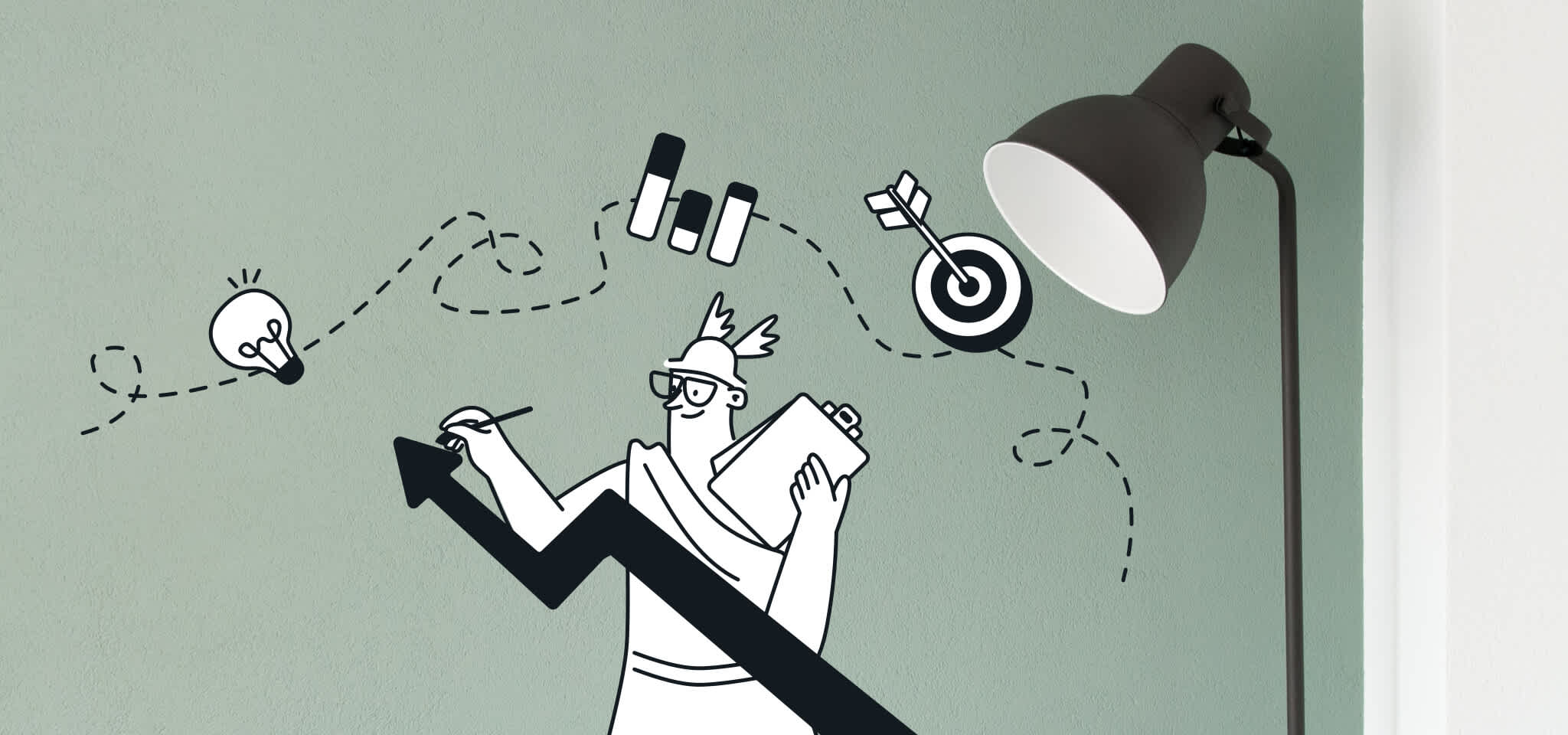Home
The Mailjet Blog
Email best practices
Email Marketing Trends for a More Efficient Strategy in 2021
Email best practices
Top email marketing trends for 2021
Start planning for the new year with our guide to 2021 email marketing trends. Learn how to build stronger connections with your audience using email.

PUBLISHED ON
Yes… It is that time of the year again. It’s time to look ahead and start planning for 2021 and we’ve got all the resources you need. Need some expert help to figure out your marketing strategy for 2021? We’ve got you! Looking for a Marketing Calendar with all the key dates for 2021? We’ve got that, too! And now the jewel in the crown is here too: ‘Email Marketing Trends’ is back, and we’ve got a new 2021 edition ready for you.
It’s no secret that 2020 gave us some unexpected trends in the way we market products and services, but what hasn’t changed is how pivotal email has been for brands all around the world. Curious to know what’s coming for email in 2021? Take out pen and paper – honestly, I think this begs for a new Moleskine – and let’s focus on how you’re going to boost your email strategy in the coming year.
Table of content
More email accessibility for small businesses
More human-centric lifecycle emails
Mindfulness of recipients’ inboxes
Renewed social consciousness
Advanced sending capabilities to maximize engagement
A more complex space in interactive design
Simplified design for increased authenticity
Increased BIMI adoption to combat phishing
2021 at Mailjet
What are the email trends for 2021?
So, let’s put it out there from the start: this last year has been hard. It has changed the way we build relationships with clients and that has affected the way we email, too. But after such a chaotic year, how different will the email world be during the next 12 months?
More email accessibility for small businesses
If there’s something the current health crisis has proven, it’s that email is the most effective way to stay in touch with our audience. You might think we’re biased, but email continues to be the best-performing marketing channel – in fact, email marketing delivers an average ROI of 4400% – and it should be the first step for every business looking to build a connection with its audience.
In 2020, brands have needed connection more than ever, and this was especially true of small businesses with fewer communication channels. Over the last year, companies like Facebook and Shopify have announced their own email products to offer these businesses even more options to choose from.
Email is one of the best ways to reach a large audience quickly and effectively, and its use will no doubt only grow as we move into 2021 and beyond. While we think the best way to do email is to enlist a professional email provider that can offer the best features and deliverability services, the increase in options can only mean one thing: email is here to stay.
Learn more about finding the right email partner
Unfortunately, email is not always as easy as just customizing a template and pressing ‘Send’. There are a lot of factors that impact your ability to reach the inbox, and the way to get this right is by finding the right email partner to help you from creation to optimization. There are many options out there, but we think Mailjet is a pretty great one and we’re sure you’ll agree once you discover all our email marketing features and deliverability support!

More human-centric lifecycle emails
If there’s something most of the experts in our Marketing Trends blog post agreed on, it’s how this year we will focus more on integrating empathy and building human connections. It’s not surprising, either. The pandemic has impacted all of us and has altered the way we communicate and interact with each other, and also with brands.
For brands, this massive shift in relationships means that they have had to adapt their messaging, channels, and timeliness of their messages – and this includes the way we email. Long gone are the days in which marketing emails would just be a collection of sales pitches and overly promotional copy.
Now, email marketing too must play its role in building a consistent user experience and a seamless customer journey. Building strong relationships with customers means understanding their needs and what they expect from our brand, and sending them messages that add value and put the customer at the heart of the strategy.
To achieve that, brands must embrace empathy as their way to better understand and relate to customers. Empathy is an attitude you can’t fake – it only works when it’s genuine and authentic. You’ll need to really understand and care about your users’ feelings, and make those feelings the integral element in any marketing communications you send them. This way, you’ll be able to build that powerful bond with them.
Learn more about using empathy in email
The art of email empathy is not easy to master, but we’ve got what you need to turn you into the next Picasso. If you want to learn more about how to integrate empathy into your email marketing strategy, Customer.io’s Marketing Director Alex Patton and Really Good Email’s Founder Matthew Smith talked about it during Email Camp… and we turned all their valuable lessons about how to build empathetic emails into a post.
Mindfulness of recipients’ inboxes
At some point during lockdown, it felt like everyone was sending email. Our inboxes became even more crowded with messages, and it was hard to tell which were really important and which were just shameless attempts to use the pandemic as a marketing weapon.
But it also became harder to keep up with everything that was happening in the digital space. Everything – work, education, social hangouts – was moved online, which meant longer periods in front of our computers and most likely some form of zoom burnout.
The combination of all these – the increase of emails in contacts’ inboxes, the screen fatigue, and the new computer habits – has changed how people interact with their inboxes and have had an impact on some brands’ engagement rates. And if you failed at navigating the changing landscape, you’ll need to make sure you’re ready to hit the ground running in 2021, because things are not likely to go back to the way they were.
Next year, brands will need to prepare for a lot more uncertainty and be ready to communicate last-minute changes accordingly to their subscribers. Email will continue to be a key channel for this; but to avoid a decrease in their engagement metrics, companies will need to ensure they are adding value and sending emails their subscribers really want to receive.
Learn more about emailing in times of crisis
As we navigate the pandemic, brands will need to adapt the sending frequency, segment email lists based on how your contacts interact with your email, and balance valuable offers with legitimate customer benefits in your email campaigns to prevent email fatigue. We’ve put together a blog post with email best practices in times of crisis to help decrease customer complaints, boost deliverability, and keep readers satisfied.
Renewed social consciousness
Not everything about 2020 has been bad, though. This year, the rise of social consciousness had a direct impact on society as a whole, helping us look beyond ourselves and encouraging us to play our role to make the world a better place. Social issues have dominated the conversation this year and have also changed the way consumers interact with companies.
Creating an emotional connection between the brand and its customers is key to strengthening the relationship with them and while, in a different era, price and offer could have been enough to keep customers coming back, consumers now expect brands to align with their values and support the causes they care about.
So it’s now time for companies to join the conversation to ensure they remain relevant in 2021. But words without actions are meaningless, so start by tapping into your brand’s purpose and ensure that this is present in the way you operate and you build relationships with both your employees and the outside world. What are your brand values? What does your brand really care about, and how are you contributing to the greater good?

Learn more about how to share your brand values via email
Once you know what you care about and you have a meaningful story to tell, make sure this is present throughout all your marketing communications, including email. In 2021, customers will continue to expect brands to play a role in making the world a better place, so brush up on your storytelling skills and prepare to let your brand values shine in your campaigns.
Advanced sending capabilities to maximize engagement
Email might be the most effective way to stay in touch with customers, but sending campaigns means nothing if those messages aren’t read. Inboxes are an increasingly competitive space, and brands have been finding it increasingly difficult to attract users’ attention now that they have to compete with ads and adapt to the different ways inboxes organize content.
That’s why we all keep trying to figure out what the best time to send a newsletter is. Send me an email about Starbucks’ new Eggnog Latte while I’m at the gym, and I’ll just ignore it. Tempt me while I’m out in the cold, and I’ll probably want to buy them all.
And to complicate things even further, the current pandemic has brought a whole new way of thinking about timeliness. The uncertainty and constant changes have forced brands to find reliable ways to communicate with their audience, but there’s no denying that our computer usage patterns have changed significantly. So, when is the best time to send that all-important email campaign? Is there really a one-time-fits-all, or does it vary from recipient to recipient?
Cracking the code to email frequency and sending times isn’t easy. During 2020, ESPs and email innovations have looked at new ways in which AI can help marketers get emails into a contact’s inbox precisely when they are most likely to read it, as a way to maximize engagement and ROI. In 2021, we will see increased adoption of machine learning to automatically adapt to individual user patterns.

Learn more about finding the right email sending time
For years, we’ve been looking for someone to tell us what the right time to send an email is. There are some common patterns and trends you can test out – you can start by checking out our recent research on best email sending times – but the perfect time normally varies depending on the list… and even the user. Tools like Send Time Optimization or Time Zone Optimization use machine learning to help you find the ideal moment for each of your subscribers and optimize sending times to reach all the different inboxes at exactly the right time.
A more complex space in interactive design
At points, it feels like our contacts’ inbox has become a muddy battlefield. Shining through is harder than ever, and going from an open to a conversion requires a lot more creativity now than it did before.
For years, we’ve been talking about the possibilities interactive email design brought to email marketers as a way to make emails more memorable and to increase shoppability. With the ability to start the purchase without leaving the inbox, interactive features eliminate the friction between email and onsite conversion.
Sending interactive emails to enable the user to convert without leaving the inbox has been a possibility for quite some time, but it’s far from being the norm. While email developers can leverage different tools to incorporate these features, the lack of a standard has made the life of email senders harder, and is likely slowing down the adoption of this trend.
Last year, we were listing Email Markup and AMP4Email as some of the options available and, this year, we’ve got one more to add to the list. Earlier this year, Microsoft dropped its support for Amp4Email (the standard supported by Gmail) and started offering its own language for interactive templates - Actionable Message. In 2021, we wouldn’t be surprised to see other mailbox providers introduce their own languages, further complicating the already complex world of interactive email.
Learn more about interactive design
Using real-time dynamic content in your emails has been a possibility for a while. If this is something new for you, though, you might want to have a look at this post on interactive email design we wrote a while ago to discover some of the components you could use in your templates.
Simplified design for increased authenticity
We have mentioned the struggle to stand out in the user’s mailbox, but, in 2021, flashier will not necessarily mean better. Email designers too will look for ways to build stronger connections with customers this year and, from time to time, that will mean stepping away from complex emails, filled with stunning images and bright CTAs, and opt for simpler designs where the layout doesn’t overshadow the message.
In 2021, brands will find a renewed love for simplified designs and plain-text emails as a way to make important messages feel more personable and authentic. Moving away from overused stock photos and product images will allow our content to shine through. Sometimes, there’s no need for flashy visuals to build a connection – a strong copy that feels unique and authentic can do just that.
Does that mean it will be the end of beautifully designed email marketing campaigns, then? Absolutely not. As we look into ways we can connect with our customers and let empathy rule our email marketing campaigns, marketers will have to reassess what the best design for each message is. Finding the right design and the right balance will allow us to get the most out of our email design.
Learn more about email design trends
But how do you find the right design to build an emotional connection? During Email Camp 2020, we asked design experts from ENGIE, BadSender, and Mailjet how they thought email design would evolve in the near future to adapt to the changing landscape. You can read all about it and learn more in our upcoming post.
Increased BIMI adoption to combat phishing
The increase in email messages throughout the pandemic has also come with an increase in phishing attempts and what’s worse – fake emails are more convincing than ever. The entire email ecosystem is in need of strong security features that allow recipients to identify the email sender and prevent them from falling prey to these malicious messages.
Earlier this year, Gmail announced its pilot to support BIMI, a security feature that allows senders to display a logo next to their messages to confirm that the email was indeed sent by the brand and not some evil impersonator. The Gmail pilot will make this security feature even more attractive to brands and in 2021 and we anticipate – and hope! – that there will be increased adoption of BIMI throughout the year as a way to gain trust from our subscribers.
Engagement rates are important for maximum deliverability, which is why Gmail’s support of BIMI is a great development for email senders. Because they’re able to see a sender’s brand logo in their inbox, Gmail users will have more confidence in opening and engaging with branded emails.

Learn more about BIMI
BIMI relies on three email authentication standards: SPF (Sender Policy Framework), DKIM (Domain Keys Identified Mail), and DMARC (Domain-based Message Authentication, Reporting & Conformance). This means that, in order to use BIMI, your domain must use these standards and have a DMARC policy of p=quarantine or p=reject defined. If you want to learn all about BIMI and how to implement it, Mailgun’s got you covered with this post.
Wrapping up
The world has changed and so has email, but we’re confident these new email marketing trends will help us build more powerful bonds with our customers, so get back to that Moleskine notebook of yours and make sure you’ve taken note.
Did you miss any? Don’t worry, here’s a recap of the email marketing trends to keep in mind for 2021.
Email will be even more accessible for small businesses.
Empathy will be key to building more human-centric lifecycle emails.
Brands will be expected to show more mindfulness of recipients’ inboxes.
The rise of social consciousness will also impact the way we create our campaigns.
Sending emails at the right time for each recipient will be even more important to maximize engagement.
Interactive email design is likely to become an even more complex space than it already was.
Recipients will demand more authentic messages, which will bring back plain-text emails and simpler designs.
The adoption of BIMI will increase as a way to combat phishing attempts and gain trust.
2021 at Mailjet
At Mailjet, we’re big fans of email (duh!) and we’ve been really proud of the role it has played this year in helping brands and customers stay connected. We know email will continue to be a key marketing channel in 2021 and we’re therefore committed to facilitating its growth.
We’re passionate about offering our clients the best tools and services, and in 2021 that will mean an even more refined email automation experience to support the way brands connect with their customers. We’ll also focus on providing even more advanced contact management features to allow users to build more targeted messages that really resonate with their audience.








